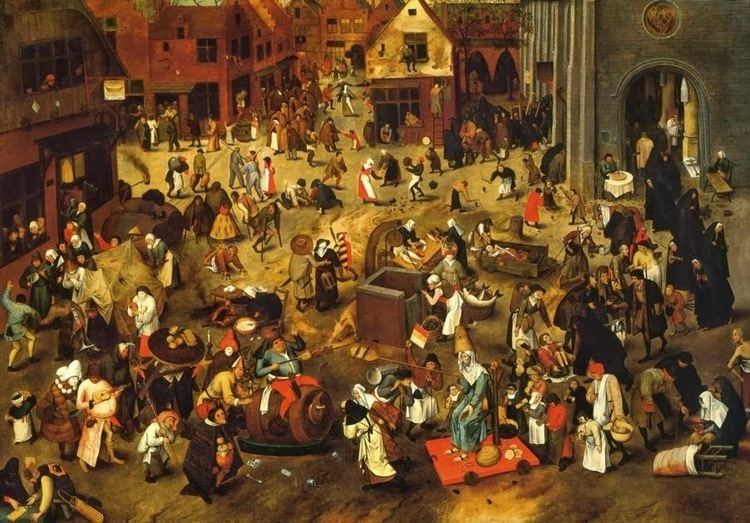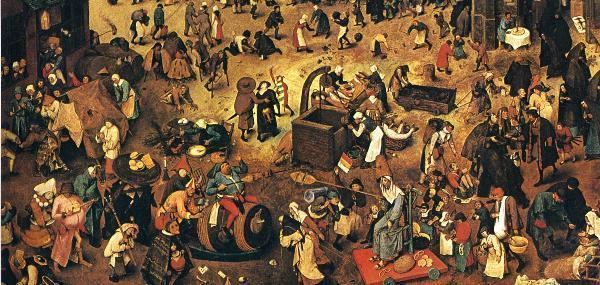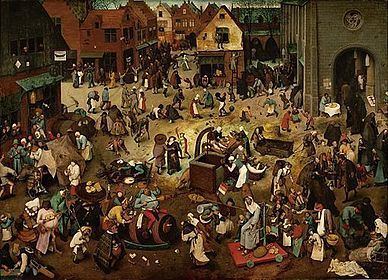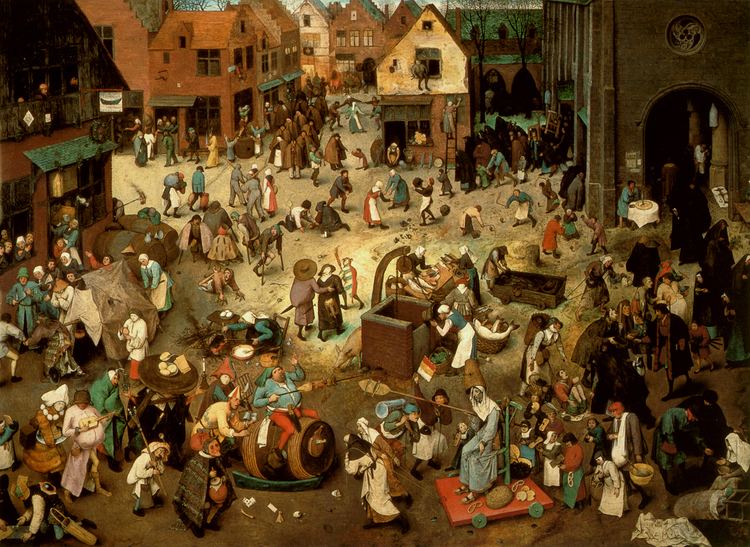Year 1559 Period Northern Renaissance | Created 1559 Genre Landscape painting | |
 | ||
Dimensions 118 cm × 164 cm (46 in × 65 in) Similar Pieter Bruegel the Elder artwork, Landscape paintings, Northern Renaissance artwork | ||
The Fight Between Carnival and Lent is an oil-on-panel work painted by Pieter Bruegel the Elder in 1559. This painting depicts a common festival of the period, as celebrated in the Southern Netherlands. It presents the contrast between two sides of contemporary life, as can be seen by the appearance of the inn on the left side - for enjoyment, and the church on the right side - for religious observance.
Contents

The busy scene depicts well-behaved children near the church and a beer drinking scene near the inn. At the centre is a well, showing the coming together of different parts of the community, and other scenes show a fish stall and two competing floats.

The painting is part of the collection at the Kunsthistorisches Museum in Vienna.
Symbolism

A battle enacted between the figures Carnival and Lent was an important event in community life in early modern Europe, representing the transition between two different seasonal cuisines: livestock that was not to be wintered was slaughtered, and meat was in good supply. As the period of Lent commenced, with its enforced abstinence and the concomitant spiritual purification in preparation for Easter, the butcher shops closed and the butchers traveled into the countryside to purchase cattle for the spring.

Bruegel's painting is rich in allegories and symbolisms that have been long studied. It is often read as the triumph of Lent, since the figure of Carnival seems to bid farewell with his left hand and his eyes lifted to the sky. A more generalised meaning may be the illustration of Bruegel's belief that human activities are motivated by folly and self-seeking.
Detail
The painting defies any linear narrative, but one may divide it into two sections: the popular and the religious. The scene is set in a town's market square (a traditional setting for the Carnival), with the figure of Carnival impersonated by a fat man who led a procession through the town and presided over a large feast. In some traditions an effigy of the Carnival figure was burned at the end of the celebrations.

In Bruegel's painting the figure is a large man riding a beer barrel with a pork chop attached to its front end. He is wearing a huge meat pie as a head-dress; he is wielding a long spit, complete with a pig's head, as a weapon for the fight. The pouch of knives at his belt indicates that he is a butcher - the guild of butchers traditionally provided the meat for the carnival feast so his place at the procession's heart is apt. The man behind the barrel is dressed in yellow, which is connected with deceit, and he is followed by a female figure who is carrying on her head a table with bread and waffles on it. In one hand she holds a tumbler and in the other a candle, again allegorical symbols for deceit. Beside her is a lute-player, which was a frequent symbol of Lutheranism. The Lutherans had abolished Lent but still celebrated the Carnival. A tavern filled with drinkers and onlookers watch the performance of a popular farce known as The Dirty Bride. At the street crossing a group of cripples have come out to beg, while behind them, led by a bagpiper, a procession of lepers walks past.
Lent's half of the picture is dominated by abstinence and piety, with people drawing water from the well, giving alms to the poor and the sick, and going to church. The church itself is the dominant building from which queues of black figures emerge from their prayers. Lady Lent in the foreground, garbed like a nun, is sitting on a cart drawn by a monk and a nun, and looks gaunt and thin, with her followers feeding on bread and biscuits. Lady Lent's wagon contains traditional Lenten foods, pretzels, waffles, and mussels. Just inside the entrance to the church a veiled statue is visible - it was customary in Roman Catholic churches to cover up all works of art at Lent until Easter Sunday when the carved and painted figures of saints would be unveiled once more, "brought back to life like the Saviour himself." In Bruegel's time, when the Protestant Reformation was surging, many of the old customs were under threat. The Roman Catholic attachment to Lenten rites was heavily criticised by the Protestant reformers and the spirit of carnival was viewed with suspicion on both sides of the religious divide.
The background is dominated by people working, primarily with food: women preparing Lenten fish, men carrying wine from the inn and a woman making waffles. At the very back of the picture, other festivities are going on with a bonfire, dancing figures and beggars spread across the whole scenery. Bruegel produced this painting from a bird's eye view, as if he wished to stay out of any polemic of the time, but he was in the habit of placing a symbolic detail in the middle of the picture, and in this case it is a married couple with their backs to the viewer, guided by a fool with a burning torch. Many critics have identified this couple as a symbol for the common masses.
The man carries a strange bulge under his clothes, giving the impression of a hunchback or a hidden sack. This is associated with the allegorical figure of Egotism, who was usually represented as carrying a sack on his back, this meaning to express man's own faults and weaknesses. It is often read as how the masses caused intolerance towards dissenters because of their inability to think objectively.
The woman's main characteristic is the unlit lantern hanging by her belt. She is guided by a fool, and not by reason. The burning torch the latter carries is also symbolic of dispute and destruction. Beside the trio is a rooting pig, also connoting damage and destruction.
